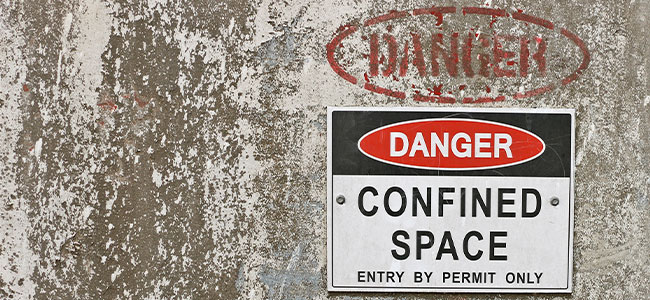
Safety Training: How to Prepare Workers for Confined Spaces While Working Alone
Effective safety training strategies are essential for prioritizing worker safety in confined spaces, particularly for those working alone.
- By Gen Handley
- Apr 12, 2024
There are dangerous, confined spaces everywhere, even where no one would know it. They exist above, below and around us in common areas such as pipelines, sewers, tankers, tunnels, storage bins and maintenance holes, where people may be required to perform work and tasks in these segregated spaces.
OSHA describes confined spaces in an occupational context as areas that may not be “necessarily designed for people, [but] they are large enough for workers to enter and perform certain jobs.” This means that a confined space is not necessarily physically small but is defined by how the entryway and exits are restricted or limited to the employee.
Why It’s Dangerous
When working in confined spaces, people are at risk of various potential hazards, making them a challenge to address and thoroughly mitigate properly. From 2011 to 2018, more than 1,000 workers died from occupational injuries involving a confined space.
Atmospheric hazards include toxic gases or fumes, explosive gases and a lack of adequate oxygen for those working in that space. Working in confined spaces where oxygen levels are low can impair judgment, result in dizziness and fatigue, and cause the worker to collapse, leading to other serious injuries if they’re alone when they pass out.
Engulfment of collapsing materials is a significant hazard when working in confined spaces such as tanks, vats and grain silos. Employees can be engulfed, buried or drowned in materials like water and liquids, grain and seed, and loose soil and sand. If working in these spaces alone, they may be unable to get help and access a safe place.
The threat of trench collapses is another significant risk when performing work in confined spaces, particularly in the construction industry, which experienced 168 deaths from 2011 to 2018 from this specific type of event and accident. This can occur when the trench walls are not adequately stabilized, benched or sloped, and any equipment or excess soil or debris is improperly stored near the edge of the trench, causing it to collapse.
Requirements for Working Alone in Confined Spaces
The OSHA has a working-alone regulation specific to working in confined spaces for shipyard employment, but they have yet to be created for other industries. However, the practices and measures required under this regulation can be used to improve the safety of lone workers in confined spaces from all industries. Under standard number 1915.84, OSHA states:
“Except as provided in § 1915.51(c)(3) of this part, whenever an employee is working alone, such as in a confined space or isolated location, the employer shall account for each employee:
- 1915.84(a)(1): Throughout each workshift at regular intervals appropriate to the job assignment to ensure the employee's safety and health; and
- 1915.84(a)(2): At the end of the job assignment or at the end of the workshift, whichever occurs first.
- 1915.84(b): The employer shall account for each employee by sight or verbal communication.”
However, the employer is also responsible for the lone worker under the General Duty Clause or duty of care, which states that companies “shall furnish to each of his employee's employment and a place of employment which are free from recognized hazards that are causing or are likely to cause death or serious physical harm to his employees.”
If their employees are required to work alone in a confined space, extra precautions must be taken, such as:
- Closer monitoring of their location in case of an emergency so that help can be dispatched to the correct coordinates as quickly as possible.
- Reliable, steady communication with that person throughout their shift so that any critical information relevant to their safety is relayed to the employer.
Why Safety Training Is Effective
One of the most effective strategies to prepare lone workers and employees for dangerous occupational circumstances is through safety training sessions and exercises. Safety training focused on specific areas such as working alone in confined spaces can help employees react in the best way possible to a bad situation in which they could get hurt.
Training for working alone in confined spaces should focus on the safe entry of the space, how this work can be performed safely within this space and protocols to exit this space safely once their work has been completed. While online and in-person safety training options are available, the interpersonal engagement that accompanies in-person training makes the extra work completely worth it. When introducing new safety training to staff, make sure the training goals are clearly communicated.
How to Plan Effective Training Sessions
Before planning a training session for confined space safety, evaluate and assess all safety hazards the workers in this confined space will face. From there, develop specific training objectives and lessons that the employees will learn to improve their safety and lower their risk. The training sessions need to be based around an engaging activity that will keep the employees focused on the lesson at hand.
Where to Start
After identifying the confined spaces and all the safety hazards, begin planning customized training sessions or look at other resources such as recommended training practices from OSHA as well as some great information from the Canadian Centre for Occupational Health and Safety.
Additionally, when planning confined safety training, make communication a priority, eliminating the danger of isolation and establishing a reliable channel to stay connected no matter where they are working. A secure line not only ensures help can be sent to the correct location, but it can also be a friendly voice during a potentially scary time for the person working.